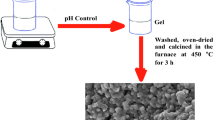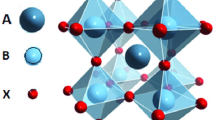Abstract
Neodymium(III) peroxotitanate is used as a precursor for obtaining Nd2TiO5. The last one possesses numerous valuable electrophysical properties. TiCl4, Nd(NO3)3·6H2O and H2O2 in mol ratio 1:2:10 were used as starting materials. The reaction ambience was alkalized to pH = 9 with a solution of NH3. The obtained neodymium(III) peroxotitanate and intermediate compounds of the isothermal heating were proved by the help of quantitative analysis and infrared spectroscopy (IRS). It has Nd4[Ti2(O2)4(OH)12]·7H2O composition. The absorption band observed in IRS at 831 cm−1 relates to a triangular bonding of the peroxo group of Ti, at 1062 cm−1—terminal groups Ti–OH and at 1491 and 1384 cm−1—the bridging OH−-groups Ti–O(H)–Ti. Nd2TiO5 was obtained by thermal decomposition of neodymium(III) peroxotitanate. The isothermal conditions for decomposition were determined on the base of differential thermal analysis, thermogravimetric and differential scanning calorimetry results in the temperature range of 20–1000 °C. The mechanism of thermal decomposition of Nd4[Ti2(O2)4(OH)12]·7H2O to Nd2TiO5 was studied. In the temperature range of 20–208 °C, a simultaneous decomposition of the peroxo groups by the separation of oxygen and hydrate water is conducted and Nd4[Ti2O4(OH)12] is obtained. From 208 to 390 °C, the terminal OH−-groups are separated and Nd4[Ti2O7(OH)6] is formed. In the range of 390–824 °C, the bridging OH−-groups are completely decomposed to Nd2TiO5. The optimal conditions for obtaining nanocrystalline Nd2TiO5 are 900 °C for 6 h and 20–80 nm.







Similar content being viewed by others
References
Connolly EJ, Tilley RJD, Arulraj A, Gundakaram R, Rao CNR. Electrical and magnetic properties of NdTiO3+δ. J Alloys Compd. 2005;388:153–7.
Pan TM, Lin JC, Wu MH, Lai CS. Structural properties and sensing performance of high-k Nd2TiO5 thin layer-based electrolyte-insulator-semiconductor for pH detection and urea biosensing. Biosens Bioelectron. 2009;24:2864–70.
Ahmadi F, Rahimi-Nasrabadi M, Behpour M. Synthesis Nd2TiO5 nanoparticles with different morphologies by novel approach and its photocatalyst application. J Mater Sci Mater Electron. 2016;. doi:10.1007/s10854-016-5692-x.
Chen H, Xiong Z, Yuan Y, Tang B, Zhang S. Dependence of microwave dielectric properties on site substitution in Ba3.75Nd9.5Ti18O54 ceramic. J Mater Sci Mater Electron. 2016;27:10951–7.
Yu S, Zhang S, Tang B, Zhou X, Fang Y. Microwave dielectric properties of BaO-2(1 − x)ZnO–xNd2O3–4TiO2 (x = 0–1.0) ceramics. Ceram Int. 2012;38:613–8.
Zvereva IA, Silyukov OI, Chislov MV. Ion-exchange reactions in the structure of perovskite-like layered oxides:I. Protonation of NaNdTiO4 complex oxide. Russ J Gen Chem. 2011;81:1434–41.
Silyukov O, Chislov M, Burovikhina A, Utkina T, Zvereva I. Thermogravimetry study of ion exchange and hydration in layered oxide materials. J Therm Anal Calorim. 2012;110:187–92.
Sefat AS, Amow G, Wu MY, Botton GA, Greedan JE. High-resolution EELS study of the vacancy-doped metal/insulator system, Nd1−xTiO3, x = 0 to 0.33. J Solid State Chem. 2005;178:1008–16.
Gong W, Zhang R. Phase relationship in the TiO2–Nd2O3 pseudo-binary system. J Alloys Compd. 2013;548:216–21.
Hayun S, Navrotsky A. Formation enthalpies and heat capacities of rear earth titanates: RE2TiO5 (RE = La, Nd and Gd). J Solid State Chem. 2012;187:70–4.
Connolly EJ. Tilley RJD. Electrical properties of the arc-melted, layered-perovskite system NdnTinO3n+2 with n = 4.5–6.5. J Alloys Compd. 2012;515:63–7.
Zhang FX, Wang JW, Lang M, Zhang JM, Ewing RC. Pressure-induced structural transformations in lanthanide titanates: La2TiO5 and Nd2TiO5. J Solid State Chem. 2010;183:2636–43.
Mohammadi MR, Fray DJ. Synthesis and characterisation of nanostructured neodymium titanium oxides by sol-gel process: Controlling the phase composition, crystal structure and grain size. Mater Chem Phys. 2010;122:512–23.
Japan Patent 51-80 Cl. C 01 G 23/00.
Shamrikova EV, Sokolova TA, Zaboeva IV. Acid buffer capacity of mineral horizons of podzolic and bog-podzolic soils of the Komi Republic. Eurasian Soil Sci. 2005;38:471–9.
Jere GV, Patel CC. Infrared absorption studies on peroxy titanium sulphate. Can J Chem. 1962;40:1576–8.
Griffith WP. Studies on transition-metal peroxy-complexes. Part III. Peroxy-complexes of groups IVA, VA, and VIA. J Chem Soc. 1964;12:5248–53.
Mihaiu S, Szilágyi IM, Atkinson I, Mocioiu OC, Hunyadi D, Pandele-Cusu J, Toader A, Munteanu C, Boyadjiev S, Madarász J, Pokol G, Zaharescu M. Thermal study on the synthesis of the doped ZnO to be used in TCO films. J Therm Anal Calorim. 2016;124:71–80.
Barabanchikova R, Limar T, Mochossoev M. Collection of Inorganic Peroxide Compounds. Moscow: Nauka; 1975 (in Russian).
Nakamoto K. IR and Raman spectra of inorganic and coordination compounds. 3rd ed. New York: Wiley and Sons; 1978.
Madej D, Szczerba J. Study of the hydration of calcium zirconium aluminate (Ca7ZrAl6O18) blended with reactive alumina by calorimetry, thermogravimetry and other methods. J Therm Anal Calorim. 2015;121:579–88.
Frost RL, Scholz R, Ruan X, Rosa Lima RMF. Thermal analysis and infrared emission spectroscopy of the borate mineral colemanite (CaB3O4(OH)3·H2O). J Therm Anal Calorim. 2016;124:131–5.
JCPDS card for XRD analysis 33-0944.
Acknowledgements
The author acknowledges thankfully the financial support for this work from the Scientific Research Centre at University of Chemical Technology and Metallurgy, Sofia (Fond “Scientific investigations” contract N-11609).
Author information
Authors and Affiliations
Corresponding author
Rights and permissions
About this article
Cite this article
Parvanova, V. Synthesis and thermal decomposition of neodymium(III) peroxotitanate to Nd2TiO5 . J Therm Anal Calorim 130, 695–700 (2017). https://doi.org/10.1007/s10973-017-6480-4
Received:
Accepted:
Published:
Issue Date:
DOI: https://doi.org/10.1007/s10973-017-6480-4




